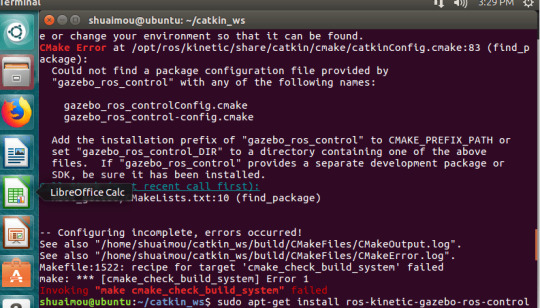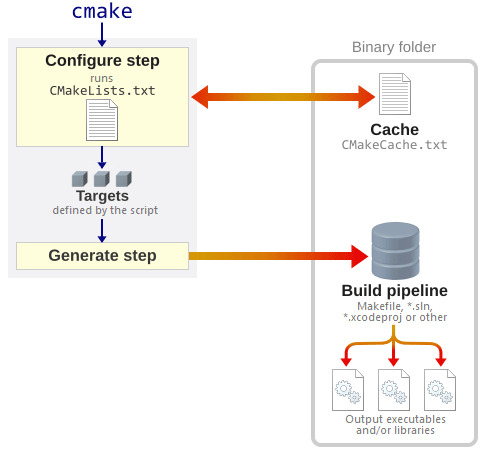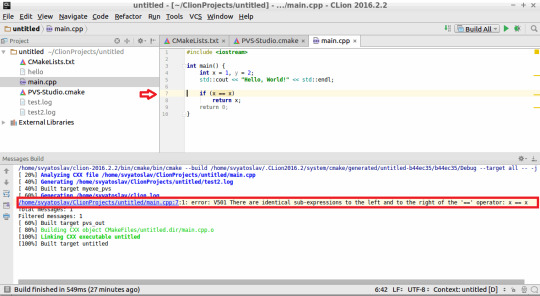#Cygwin cmake command not found
Explore tagged Tumblr posts
Text
Cygwin cmake command not found

When I run make in the specific directory it works as well (BUT: compiler identification is 6.4.0 while my custom compiler id is 6.1.0). Make: *** Fehler 2Īs I see it, the file testCCompiler.c is missing while running gcc-6.1.0.īut when I compile it manually after cmake has failed, it runs successfully. Make: Verzeichnis „/cygdrive/d/programming/cpp/T2D/build/CMakeFiles/CMakeTmp“ wird verlassen I686-w64-mingw32-gcc-6.1.0.exe: error: /cygdrive/d/programming/cpp/T2D/build/CMakeFiles/CMakeTmp/testCCompiler.c: No such file or directory opt/mingw32-1.6.0/bin/i686-w64-mingw32-gcc-6.1.0.exe -o CMakeFiles/cmTC_5e0c4.dir/testCCompiler.c.o -c /cygdrive/d/programming/cpp/T2D/build/CMakeFiles/CMakeTmp/testCCompiler.c Make: Verzeichnis „/cygdrive/d/programming/cpp/T2D/build/CMakeFiles/CMakeTmp“ wird betretenīuilding C object CMakeFiles/cmTC_5e0c4.dir/testCCompiler.c.o usr/bin/make -f CMakeFiles/cmTC_5e0c4.dir/build.make CMakeFiles/cmTC_5e0c4.dir/build Run Build Command:"/usr/bin/make.exe" "cmTC_5e0c4/fast" This is the output from the CMakeError.log file: Determining if the C compiler works failed with the following output:Ĭhange Dir: /cygdrive/d/programming/cpp/T2D/build/CMakeFiles/CMakeTmp (Used -debug-trycompile to keep temporary files) When I try to manually make the temporary files after cmake failed, the make command runs successfully. I have already tried several approaches to fix my problem, until I got to the point where it only fails on finding testCCompiler.c from the directory CmakeTmp. I have a problem while running cmake with a mingw32 custom compiler in a cygwin terminal.

0 notes
Text
Cmake Makefile

Description
Makefile Syntax. A Makefile consists of a set of rules.A rule generally looks like this: targets: prerequisites command command command. The targets are file names, separated by spaces. Typically, there is only one per rule. The concept of CMake. CMake makes your makefile. Cmake relies on a top level file called CMakeLists.txt; now we can first delete our makefile and out in the previous section. First check our cmake version. 1: cmake -version: You can also use the command cmake to check the usage.
This is a very simple C++ Makefile example and associated template, that can be used to get small to medium sized C++ projects up and running quickly and easily. The Makefile assumes source code for the project is broken up into two groups, headers (*.hpp) and implementation files (*.cpp). The source code and directory layout for the project is comprised of three main directories (include, src and build), under which other directories containing code would reside. The layout used in the example is as follows:
Directory Purpose Project / include Header files (*.hpp, *.h, *.hxx, *.h++)Project / src Implementation files (*.cpp)Project / build / objectsObject files (*.o)Project / build / apps Executables
The Makefile
The Makefile supports building of a single target application called program which once built will be placed in the build/apps directory. All associated objects will be placed in the build/objects directory. The following is a listing of the Makefile in its entirety:
The Makefile and a complete example including source code and directory layout can be downloaded from: HERE
Makefile Commands
The following commands can be used with this Makefile:
make all
make clean
make program
make build
make release
make debug
make info
Example Run

The following is the expected output when the command 'make clean all' is executed:
CMake Version
A CMake based build configuration of the above mentioned project structure can be found HERE
Preface Introduction Under the hood of Visual Studio GNU/Linux Equivalent Visual Studio to Make Utility mapping Example Source Structure Build Run Makefile Details Targets Dependencies Contents NMake Conclusion External Links
If you develop software only on Windows using Visual studio, it’s a luxury. Enjoy it while it lasts. Sooner than later, you will come across Makefiles, maybe exploring some software on Linux or the misfortune of having a build system that uses make with Cygwin on Windows.
Now you figure out that Makefiles are text files and open it in an editor hoping to get some insight into its workings. But, what do you see? Lots of cryptic hard to understand syntax and expressions. So, where do you start? Internet searches for make and Makefiles provide a lot of information but under the assumption that you come from a non-IDE Unix/Linux development environment. Pampered Visual Studio developers are never the target audience.
Here I will try to relate to the Visual Studio build system which will hopefully give an easier understanding of Makefiles. The goal is not to provide yet another tutorial on makefiles (because there are plenty available on the internet) but to instill the concept by comparison.
Visual Studio provides features that are taken for granted until you have to read/create a classic Makefile. For example, Visual Studio auto-magically does the following.
Compiles all the sources in the project file
Create an output directory and puts all the intermediate object files in it
Manages dependencies between the source and object files
Manages dependencies between the object files and binaries
Links the object files and external dependent libraries to create binaries
All of the above have to be explicitly specified in a Makefile. The make utility in some ways is the equivalent of Visual Studio devenv.exe (without the fancy GUI).
Visual Studio is essentially a GUI over the compilation and link process. It utilizes an underlying command line compiler cl.exe and linker link.exe. Additionally, it provides a source code editor, debugger and other development tools.
A simple win32 console application project in Visual Studio is shown below. You have a solution file which contains a project file.
Invoking a build on the solution in Visual Studio calls something like the following under the hood. Yes, it looks ugly! But that is the the project properties translated to compiler/linker flags and options.
It is very similar in GNU/Linux. The equivalent of a compiler and linker is gcc, the GNU project C and C++ compiler. It does the preprocessing, compilation, assembly and linking.
Shown below is a very simple Makefile which can be accessed from GitHub https://github.com/cognitivewaves/Simple-Makefile.
Invoking the make command to build will output the following.
Below is a table relating Visual Studio aspects to Make utility. At a high level, the Project file is equivalent to a Makefile.
Visual Studiomake UtilityCommanddevenv.exemakeSource structure Solution (.sln) has project files (typically in sub-directories)Starting at the root, each Makefile can indicate where other Makefiles (typically in sub-directories) existLibrary build dependencySolution (.sln) has projects and build orderMakefileSource files listProject (.vcproj)MakefileSource to Object dependencyProject (.vcproj)MakefileCompile and Link optionsProject (.vcproj)MakefileCompilercl.exegcc, g++, c++ (or any other compiler, even cl.exe)Linkerlink.exegcc, ld (or any other linker, even link.exe)
Download the example sources from GitHub at https://github.com/cognitivewaves/Makefile-Example. Note that very basic Makefile constructs are used because the focus is on the concept and not the capabilities of make itself.
Source Structure
Build
Visual Studiomake UtilityBuilding in Visual Studio is via a menu item in the IDE or invoking devenv.exe on the .sln file at the command prompt. This will automatically create the necessary directories and build only the files modified after the last build.Initiating a build with makefiles is to invoke the make command at the shell prompt. Creating output directories has to be explicitly done either in the Makefile or externally.
Cmake Command Line
In this example, to keep the makefiles simple, the directories are created at the shell prompt.

The make utility syntax is shown below. See make manual pages for details.
Execute the command make and specify the “root” Makefile. However, it is more common to change to directory where the “root” Makefile exists and call make. This will read the file named Makefile in the current directory and call the target all by default. Notice how make enters sub-directories to build. This is because of nested Makefiles which is explained later in the Makefiles Details section.
Run
Once the code is built, run the executable. This is nothing specific to makefiles but has been elaborated in case you are not familiar with Linux as you will notice that by default is will fail to run with an error message.
This is because the executable app.exe requires the shared object libmath.so which is in a different directory and is not in the system path. Set LD_LIBRARY_PATH to specify the path to it.
Makefile Details
The basis of a Makefile has a very simple structure.

The (tab) separator is very important! Spaces instead of a (tab) is not the same. You will see rather obscure error messages as shown below. Makefile:12: *** missing separator. Stop.

Targets
Here target is a physical file on disk. When the target is more of a label, then it has to be tagged as .PHONY to indicate that the target is not an actual file.
Visual Studiomake UtilityVisual Studio by default provides options to clean and rebuild a project or solution.Clean and rebuild have to be explicitly written in a makefile as targets which can then be invoked.

A typical case would be to clean before rebuilding.
Dependencies
Dependencies can be files on disk or other targets (including phony targets).
Visual Studiomake UtilityVisual Studio by default supports implicit dependencies (source to object files) within a project. Library(project) dependencies have to specified in the solution fileEvery dependency has to be explicitly defined in makefiles
Cmake Makefile Generator
For example, the target all, depends on app.exe which in turn depends on libmath.so. If you remove app.exe, make is capable of recognizing that libmath.so need not be built again.
Contents
Cmake Makefile Link
File: Makefile
File: math/Makefile
Cmake Makefile Difference
File: app/Makefile
NMake is the native Windows alternative to the *nix make utility. The syntax is very similar to *nix makefiles. However, this does not mean that *nix makefiles can be executed seamlessly on Windows. See Makefiles in Windows for a discussion.
Makefiles are very powerful and gives a lot of control and flexibility compared to Visual Studio, but the content is not easily understandable. As an alternative, CMake has adopted similar concepts but the script is much easier and more readable. See CMake and Visual Studio.

1 note
·
View note